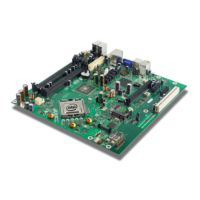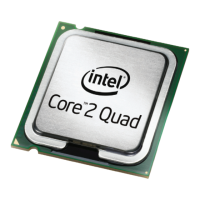LGA775 Socket Heatsink Loading
Thermal and Mechanical Design Guidelines 69
Appendix A LGA775 Socket Heatsink
Loading
A.1 LGA775 Socket Heatsink Considerations
Heatsink clip load is traditionally used for:
• Mechanical performance in mechanical shock and vibration
Refer to Section 6.7.1 for the information on the structural design strategy for the
reference design
• Thermal interface performance
Required preload depends on TIM
Preload can be low for thermal grease
In addition to mechanical performance in shock and vibration and TIM performance,
LGA775 socket requires a minimum heatsink preload to protect against fatigue failure
of socket solder joints.
Solder ball tensile stress is originally created when, after inserting a processor into the
socket, the LGA775 socket load plate is actuated. In addition, solder joint shear stress
is caused by coefficient of thermal expansion (CTE) mismatch induced shear loading.
The solder joint compressive axial force (F
axial
) induced by the heatsink preload helps
to reduce the combined joint tensile and shear stress.
Overall, the heatsink required preload is the minimum preload needed to meet all of
the above requirements—Mechanical shock and vibration and TIM performance AND
LGA775 socket protection against fatigue failure.
A.2 Metric for Heatsink Preload for ATX/uATX
Designs Non-Compliant with Intel
®
Reference Design
A.3 Heatsink Preload Requirement Limitations
Heatsink preload by itself is not an appropriate metric for solder joint force across
various mechanical designs and does not take into account for example (not an
exhaustive list):
• Heatsink mounting hole span
• Heatsink clip/fastener assembly stiffness and creep
• Board stiffness and creep
• Board stiffness is modified by fixtures like backing plate, chassis attach, and so
forth.

